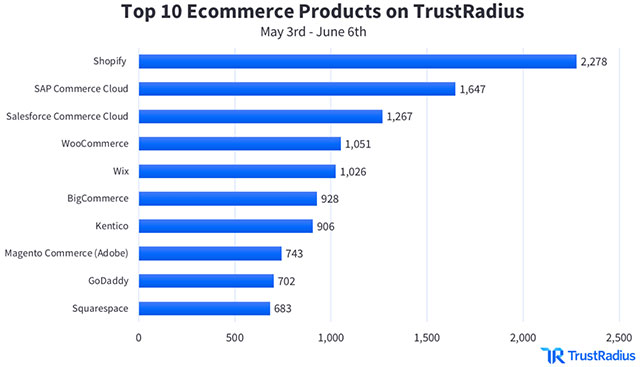Shoppers are starting to come back to their favorite brick and mortar storefronts as the pandemic restrictions allow consumers to exit from lockdown. But the impact of COVID-19 has etched some far-reaching changes in the retail industry that will not set back the strides online shopping has gained since March.
A new normal for retail remains in the wake of the forced reshaping of how retailers and consumers do business. Some employees are heading back to their physical offices as store workers settle into the reopenings.
For instance, some of the key highlights show the new top online shopping platforms for consumers in order of traffic are Shopify, SAP Commerce Cloud, and Salesforce Commerce Cloud, according to the review site for business technology.
To be clear, when referring to e-commerce software, TrustRadius means platforms or plugins that allow online sellers to create and host an e-commerce website, display a product catalog, offer a shopping cart, and provide customers with a secure way to conduct online transactions.
The company’s research includes both comprehensive e-commerce platforms from vendors like Shopify, SAP, Oracle, and BigCommerce. It also includes customer management systems plugins like WooCommerce in the report’s e-commerce platforms category, explained Megan Headley, vice president of research at TrustRadius.
“TrustRadius does not use an e-commerce platform. Instead, we provide verified customer reviews for e-commerce software products,” she told the E-Commerce Times.
Key Highlights
Predictions say that there could be between 20,000 to 25,000 storefront closures in the U.S. in 2020 as a result of the pandemic. As of June, total retail spending in the U.S. is expected to decline by about 10.5 percent for 2020.
The two primary sales channels that make up ‘total retail spending’ have seen opposite trends during the COVID-19 pandemic. While brick-and-mortar retail sales are expected to decrease by 14 percent, e-commerce sales are predicted to increase by 18 percent to US$710 billion in 2020.
“While the total retail sales have seen a large decrease during the first half of 2020, e-commerce sales have surged,” Headley reiterated.
Losses from in-person sales have made a large dent in the retail market. Online sales have soared as a result of the COVID-19 pandemic.
A huge spike took place over interest in e-commerce software, according to TrustRadius’ analysis. This spike was particularly evident among small business-friendly platforms like Shopify. TrustRadius has seen an 85 percent increase in traffic to the e-commerce software category from January through May 2020.
In light of COVID-19 impact on retail sales, these statistics could be very encouraging for people in the e-commerce community, according to observers.
For instance, 45 percent of e-commerce traffic currently comes from enterprises. Traffic to this category has increased by 85 percent in the past few months.
Research Methods
TrustRadius is a hub for buyers, sellers, experts, and users of business technology. So the activity we see on our website can be a helpful proxy for market trends, noted Headley.
To collect this data specifically, her company examined internal website traffic usage reports using Google Analytics. Researchers verified that the patterns viewed reflected broader market dynamics using external data from sources like Google Trends.
The company’s researchers used reports from sources such as the New York Times, eMarketer, Statista.com, and the Washington Post to help researchers better understand the narrative behind the numbers they were seeing, Headley explained.
E-Commerce Software Demand
The company monitors all types of B2B technology. It has taken a keen interest in actively tracking how the COVID-19 pandemic has affected multiple software and hardware categories, including the e-commerce industry.
TrustRadius reports aim to help both software buyers and vendors navigate this new business environment. More specifically, to help e-commerce software buyers find the product that best matches their business needs, the company conducts sentiment analysis on the review data it collects.
The company also provides average ratings across a variety of product attributes. It then publishes a TrustMap that displays the relative popularity and overall score of products on TrustRadius, Headley detailed about her company’s mission.
“Based on data from TrustRadius and external sources, it’s clear that interest in e-commerce software has been increasing as of February 2020,” she said.
The resulting spike in website traffic for products like Shopify, SAP Commerce Cloud, and Salesforce Commerce Cloud is a key indicator.

At play is a unique opportunity for e-commerce software vendors to reach out to their current and future customers to see how they are being impacted by the pandemic and offer support, Headley suggested.
She sees a two-fold gain for those who do. One, there are likely additional e-commerce tools or strategies vendors can provide that will help their customers adapt to the changing business environment.
Two, from re-thinking pricing tiers to developing new features, the impacts of the pandemic will change how e-commerce platforms go to market. Reviews from customers can help e-commerce software companies collect the intelligence they need.
Changing Times
The digital ecosystem is now much larger than we had predicted several months ago. It will only continue to grow moving forward, as it has become more nuanced and complex with the rise of direct-to-consumer, according to Michael Lagoni, CEO of Stackline.
“Historically, less than 10 percent of consumer brands and manufacturers sold products directly through their own direct-to-consumer site. Now, in 18 months, the ratio will be completely flipped, and the vast majority of brands will be operating a DTC platform of their own,” he told the E-Commerce Times. “The current DTC, e-commerce competitive landscape is going to be completely transformed.”
Until recently, smaller, more entrepreneurial digitally native brands built awareness through Facebook and Instagram. They ran their e-commerce business more nimbly around larger incumbent brands, who historically focused on the brick and mortar channel, Lagoni explained.
However, many of the large incumbent manufacturers and brands who failed to put resources into e-commerce or integrate direct-to-consumer platforms, because of channel conflicts, are recognizing they cannot be as reliant on brick and mortar.
“They’re navigating and changing their strategy very rapidly. Now, you’re going to see a new wave of market entrance. Larger, more traditional brands will replicate digital marketing growth strategies smaller entrepreneurial companies employed successfully in the past,” Lagoni predicted.
Pandemic Fueling E-Commerce Growth
The past quarter’s events have had conditions no one could foresee. E-commerce was already a growing industry that was forecasted to keep growing, according to Ben Parr, co-founder and president of Octane AI.
“The global pandemic caused E-Commerce growth to accelerate a couple of years ahead of what was forecast,” he told the E-Commerce Times. “With stores shutting their doors due to the pandemic, consumers who had never shopped online before discovered online shopping and recognized it as a comfortable option.”
Even with stores reopening, most consumers will view non-essential shopping as a risk, Parr continued. As the economy reopens, consumers will determine if the products they need are worth the risk of going into a brick-and-mortar store.
“They will choose to shop online in almost every case,” he said.
Paradigm Shift
The paradigm has shifted forever, resulting in e-Commerce and other DTC consumer channels have become the cornerstone of a brands business, offered Shelly Socol, co-founder of One Rockwell, a digital commerce agency located in New York City.
“In the past, brand wholesale and retail channels were the foundation, and you would layer in e-commerce on top of that. With COVID this structure has been flipped on its head. There will be those who saw this early and succeeded, and those who could not make that shift will not survive,” she told the E-Commerce Times.
Even with all the adjustments being made by retail stores to encourage shoppers to feel safe and return to an in-store shopping experience, more people will be shopping on their devices as it is the safest way to shop.
Online shopping will double or triple from the past. E-commerce will be the main channel where brands will invest their resources, and that being so, will guide their overall strategy, Socol suggested.
![]()


 Jack M. Germain has been an ECT News Network reporter since 2003. His main areas of focus are enterprise IT, Linux and open source technologies. He has written numerous reviews of Linux distros and other open source software.
Jack M. Germain has been an ECT News Network reporter since 2003. His main areas of focus are enterprise IT, Linux and open source technologies. He has written numerous reviews of Linux distros and other open source software.





